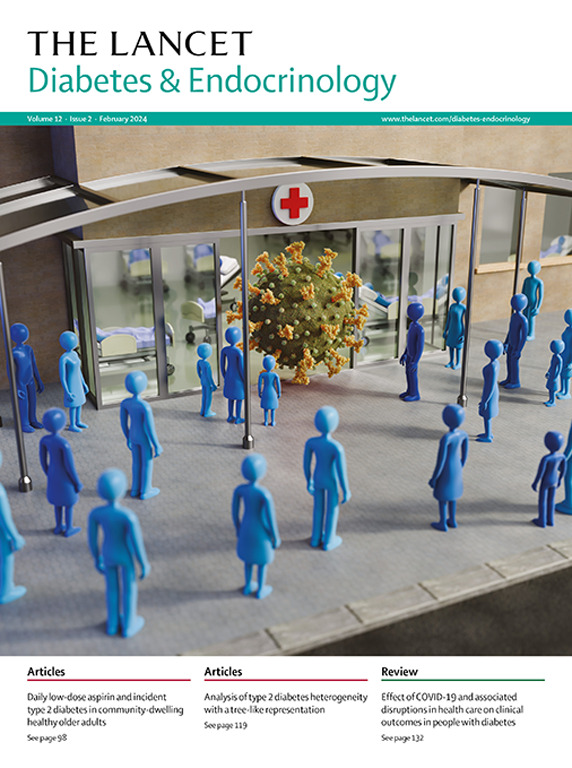杂合子家族性高胆固醇血症成人的体重指数、降脂药物和年龄与 2 型糖尿病患病率的关系:一项全球性横断面研究
IF 44
1区 医学
Q1 ENDOCRINOLOGY & METABOLISM
引用次数: 0
摘要
背景他汀类药物是治疗杂合子家族性高胆固醇血症患者的基础药物,但研究表明这可能会增加普通人群罹患 2 型糖尿病的风险。据报道,在一些家族性高胆固醇血症队列中,2型糖尿病的发病率较低,这就提出了一个问题:这些患者是否可以预防2型糖尿病?肥胖是众所周知的 2 型糖尿病发病风险因素。我们的目的是研究已知的 2 型糖尿病主要决定因素与杂合子家族性高胆固醇血症患者中 2 型糖尿病发病率的关系。方法这项全球性横断面研究使用了 EAS FHSC 登记处的个人水平数据,研究对象包括 18 岁以上、经临床或基因诊断为杂合子家族性高胆固醇血症且有年龄、体重指数和糖尿病状态数据的成年人。已知或疑似患有同型家族性高胆固醇血症和 1 型糖尿病的人被排除在外。研究的主要结果是 2 型糖尿病的总体患病率和世界卫生组织地区的患病率,以及与肥胖(体重指数≥30-0 kg/m2)和降脂药物相关的预测因素。根据年龄(三等分)、肥胖和接受他汀类药物的情况,将研究人群分为 12 个风险类别,并采用逻辑回归法对 2 型糖尿病的风险进行了调查。研究结果在 46 683 名拥有 FHSC 登记册中个人数据的成年人中,有 24 784 名患有杂合子家族性高胆固醇血症的人被纳入来自 44 个国家的分析中。其中19 818人(80%)经基因确诊为杂合型家族性高胆固醇血症。2 型糖尿病在总人口中的发病率为 5-7%(24 784 人中有 1415 人),在基因确诊人群中的发病率为 4-1%(19 818 人中有 817 人)。与欧洲(不包括荷兰;6579 人中有 527 人[8-0%])相比,东地中海地区(194 人中有 58 人[29-9%])、东南亚和西太平洋地区(1785 人中有 214 人[12-0%])和美洲地区(1955 人中有 166 人[8-5%])的 2 型糖尿病患病率更高。年龄越大、体重指数越高(肥胖和超重)以及服用降脂药与罹患 2 型糖尿病的风险越高有关,与性别和低密度脂蛋白胆固醇无关。在 12 个风险类别中,最高风险类别(55-98 岁、肥胖、服用他汀类药物;OR 74-42 [95% CI 47-04-117-73])人群患 2 型糖尿病的概率高于最低风险类别(18-38 岁、无肥胖、未服用他汀类药物)人群。那些没有肥胖症的人,即使他们的年龄处于较高的三等分中,并且正在接受他汀类药物治疗,他们罹患 2 型糖尿病的风险也较低(OR 24-42 [15-57-38-31])。在基因诊断队列中,最高风险类别中肥胖者的相应结果为 OR 65-04(40-67-104-02),无肥胖者的相应结果为 OR 20-07(12-73-31-65)。肥胖明显增加了这些患者与年龄和他汀类药物使用相关的糖尿病风险。我们的研究结果表明,杂合子家族性高胆固醇血症不能预防2型糖尿病,因此控制肥胖对减少这类患者的2型糖尿病至关重要。本文章由计算机程序翻译,如有差异,请以英文原文为准。
Association of BMI, lipid-lowering medication, and age with prevalence of type 2 diabetes in adults with heterozygous familial hypercholesterolaemia: a worldwide cross-sectional study
Background
Statins are the cornerstone treatment for patients with heterozygous familial hypercholesterolaemia but research suggests it could increase the risk of type 2 diabetes in the general population. A low prevalence of type 2 diabetes was reported in some familial hypercholesterolaemia cohorts, raising the question of whether these patients are protected against type 2 diabetes. Obesity is a well known risk factor for the development of type 2 diabetes. We aimed to investigate the associations of known key determinants of type 2 diabetes with its prevalence in people with heterozygous familial hypercholesterolaemia.Methods
This worldwide cross-sectional study used individual-level data from the EAS FHSC registry and included adults older than 18 years with a clinical or genetic diagnosis of heterozygous familial hypercholesterolaemia who had data available on age, BMI, and diabetes status. Those with known or suspected homozygous familial hypercholesterolaemia and type 1 diabetes were excluded. The main outcome was prevalence of type 2 diabetes overall and by WHO region, and in relation to obesity (BMI ≥30·0 kg/m2) and lipid-lowering medication as predictors. The study population was divided into 12 risk categories based on age (tertiles), obesity, and receiving statins, and the risk of type 2 diabetes was investigated using logistic regression.Findings
Among 46 683 adults with individual-level data in the FHSC registry, 24 784 with heterozygous familial hypercholesterolaemia were included in the analysis from 44 countries. 19 818 (80%) had a genetically confirmed diagnosis of heterozygous familial hypercholesterolaemia. Type 2 diabetes prevalence in the total population was 5·7% (1415 of 24 784), with 4·1% (817 of 19 818) in the genetically diagnosed cohort. Higher prevalence of type 2 diabetes was observed in the Eastern Mediterranean (58 [29·9%] of 194), South-East Asia and Western Pacific (214 [12·0%] of 1785), and the Americas (166 [8·5%] of 1955) than in Europe (excluding the Netherlands; 527 [8·0%] of 6579). Advancing age, a higher BMI category (obesity and overweight), and use of lipid-lowering medication were associated with a higher risk of type 2 diabetes, independent of sex and LDL cholesterol. Among the 12 risk categories, the probability of developing type 2 diabetes was higher in people in the highest risk category (aged 55–98 years, with obesity, and receiving statins; OR 74·42 [95% CI 47·04–117·73]) than in those in the lowest risk category (aged 18–38 years, without obesity, and not receiving statins). Those who did not have obesity, even if they were in the upper age tertile and receiving statins, had lower risk of type 2 diabetes (OR 24·42 [15·57–38·31]). The corresponding results in the genetically diagnosed cohort were OR 65·04 (40·67–104·02) for those with obesity in the highest risk category and OR 20·07 (12·73–31·65) for those without obesity.Interpretation
Adults with heterozygous familial hypercholesterolaemia in most WHO regions have a higher type 2 diabetes prevalence than in Europe. Obesity markedly increases the risk of diabetes associated with age and use of statins in these patients. Our results suggest that heterozygous familial hypercholesterolaemia does not protect against type 2 diabetes, hence managing obesity is essential to reduce type 2 diabetes in this patient population.Funding
Pfizer, Amgen, MSD, Sanofi-Aventis, Daiichi-Sankyo, and Regeneron.求助全文
通过发布文献求助,成功后即可免费获取论文全文。
去求助
来源期刊

The Lancet Diabetes & Endocrinology
ENDOCRINOLOGY & METABOLISM-
CiteScore
61.50
自引率
1.60%
发文量
371
期刊介绍:
The Lancet Diabetes & Endocrinology, an independent journal with a global perspective and strong clinical focus, features original clinical research, expert reviews, news, and opinion pieces in each monthly issue. Covering topics like diabetes, obesity, nutrition, and more, the journal provides insights into clinical advances and practice-changing research worldwide. It welcomes original research advocating change or shedding light on clinical practice, as well as informative reviews on related topics, especially those with global health importance and relevance to low-income and middle-income countries. The journal publishes various content types, including Articles, Reviews, Comments, Correspondence, Health Policy, and Personal Views, along with Series and Commissions aiming to drive positive change in clinical practice and health policy in diabetes and endocrinology.
 求助内容:
求助内容: 应助结果提醒方式:
应助结果提醒方式:


